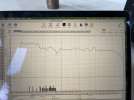Crossovers are often used to linearize driver responses, and that is where sensitivity is "discarded". If you look at the new LSA bookshelf speakers that are supposed to have such great bass for their size, they are about 83dB per watt at 1 meter which is REALLY insensitive, meaning you would need a lot of power to get lifelike volume levels from them at any reasonable seating distance. Not that I would want or expect lifelike levels from little bookshelves.I'm sure it depends. A tweeter might have a series resistor making it require more power (but who cares?). A woofer crossover would often have minimal impedance until it starts rolling off. In general I'm not sure crossovers are much to blame for low speaker sensitivity.
My point is that the bass extension comes at a price.
Last edited:

